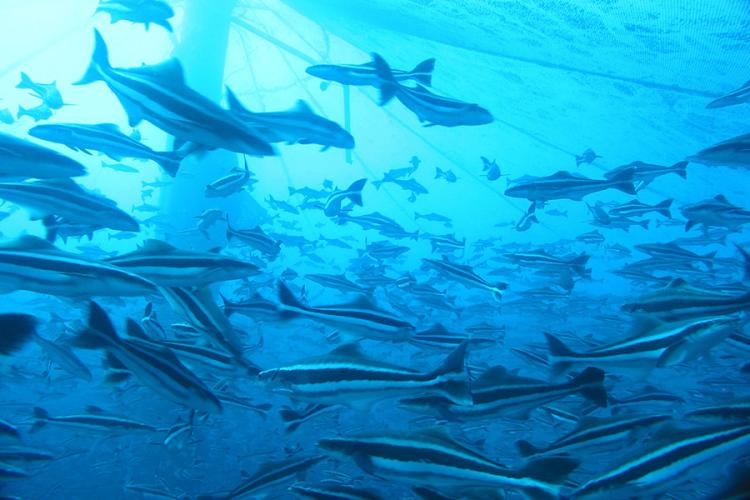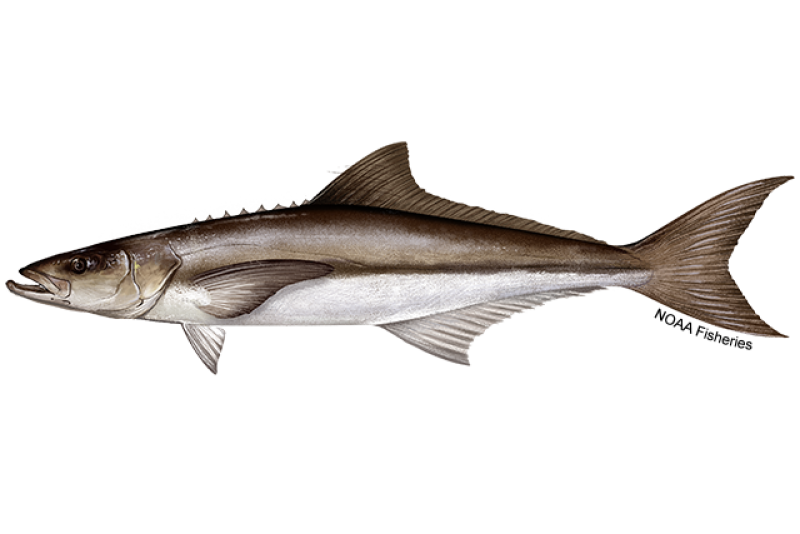 Cobia. Credit: NOAA Fisheries
Cobia. Credit: NOAA Fisheries
Cobia. Credit: NOAA Fisheries
About the Species
 Cobia. Credit: NOAA Fisheries
Cobia. Credit: NOAA Fisheries
Cobia. Credit: NOAA Fisheries
U.S. wild-caught cobia is a smart seafood choice because it is sustainably managed and responsibly harvested under U.S. regulations.

Population
The stock is not overfished.

Fishing Rate
Subject to overfishing.

Habitat Impact
Fishing gear used to catch cobia rarely contacts the ocean floor and has minimal impacts on habitat.

Bycatch
Minimal, as commercial fishermen rarely target cobia.
Population Status
- According to the 2020 stock assessment, the Gulf of Mexico stock is not overfished but is subject to overfishing. Summary stock assessment information can be found on Stock SMART.
- Scientists from NOAA's Southeast Fisheries Science Center monitor the abundance of the population, and scientists, managers, and stakeholders assess the status of the stock through the Southeast Data, Assessment, and Review (SEDAR) process.
Appearance
- Cobia are dark brown with a single dorsal fin.
- Young cobia have distinct coloring, with alternating black and white horizontal stripes and splotches of bronze, orange, and green.
- Cobia are often mistaken for sharks or remoras. In fact, their closest living relative is the remora (shark sucker).
Biology
- Cobia are the only member of the family Rachycentridae in North America.
- They grow up to 6 feet and 100 pounds and live up to 12 years.
- They are able to reproduce when they are young—females mature at age 3 and males mature at age 2.
- Cobia spawn in coastal bays and estuaries several times throughout their spawning season, which lasts from late June to mid-August in the Southeast and from late summer to early fall in the Gulf of America. Females release between 375,000 and 2 million eggs each time they spawn.
- They are strong, aggressive predators, mainly feeding on crustaceans but also fish and squid. Larger pelagic fish prey on young cobia.
Where They Live
Range
- In U.S. waters, cobia are most abundant from Virginia south through the Gulf of America (formerly Gulf of Mexico).
- Cobia migrate seasonally in the Atlantic and Gulf of America.
- Along the Atlantic coast, they move south and offshore toward warmer waters during the late fall and winter.
- Cobia found in the northeastern Gulf of America during the summer move to south Florida waters in the winter, possibly spending the winter near the Florida Keys.
Habitat
- Cobia are found near structures in the water (buoys, debris, shipwrecks, and artificial reefs) or large animals (sharks, turtles, and stingrays).
- Adult cobia travel alone or in small groups..
Fishery Management
- NOAA Fisheries and the Gulf Council manage cobia in the Gulf of America and on the east coast of Florida.
- The Atlantic migratory group cobia (from Georgia through New York) are managed by the Atlantic States Marine Fisheries Commission.
- Managed under the Fishery Management Plan for Coastal Migratory Pelagics in the Atlantic and Gulf of Mexico:
- Fishermen do not need a federal permit to harvest cobia.
- Gear restrictions:
- Drift gillnets are prohibited.
- Authorized gear includes automatic reel, bandit gear, handline, rod-and-reel, and pelagic longline.
- Cobia must be a minimum size to be harvested, and must be landed with their heads and fins intact. Current minimum size limit is 33 inches fork length. Amendment 7 will be increasing the minimum size limit to 36 inches fork length.
- Commercial and recreational fishermen have size limits, trip limits, and per person per day or per vessel per day bag limits.
- Annual catch limits based on best available science.
Harvest
- Commercial fishery:
- In 2023, commercial landings of cobia totaled 99,500 pounds and were valued at $366,000 according to the NOAA Fisheries commercial fishing landings database.
- Commercial fishermen do not directly target cobia and usually catch it while trawling for shrimp or fishing for other species such as mackerel.
- Recreational fishery:
- Recreational fishermen like cobia because it is a large, powerful fish that puts up a good fight and provides a tasty meal.
- In 2023, recreational anglers landed 4.9 million pounds of cobia, according to the NOAA Fisheries recreational fishing landings database.
Scientific Classification
- In U.S. waters, cobia are most abundant from Virginia south through the Gulf of America (formerly Gulf of Mexico).
- Cobia migrate seasonally in the Atlantic and Gulf of America.
- Along the Atlantic coast, they move south and offshore toward warmer waters during the late fall and winter.
- Cobia found in the northeastern Gulf of America during the summer move to south Florida waters in the winter, possibly spending the winter near the Florida Keys.
- Cobia are found near structures in the water (buoys, debris, shipwrecks, and artificial reefs) or large animals (sharks, turtles, and stingrays).
- Adult cobia travel alone or in small groups..
Fishery Management
- NOAA Fisheries and the Gulf Council manage cobia in the Gulf of America and on the east coast of Florida.
- The Atlantic migratory group cobia (from Georgia through New York) are managed by the Atlantic States Marine Fisheries Commission.
- Managed under the Fishery Management Plan for Coastal Migratory Pelagics in the Atlantic and Gulf of Mexico:
- Fishermen do not need a federal permit to harvest cobia.
- Gear restrictions:
- Drift gillnets are prohibited.
- Authorized gear includes automatic reel, bandit gear, handline, rod-and-reel, and pelagic longline.
- Cobia must be a minimum size to be harvested, and must be landed with their heads and fins intact. Current minimum size limit is 33 inches fork length. Amendment 7 will be increasing the minimum size limit to 36 inches fork length.
- Commercial and recreational fishermen have size limits, trip limits, and per person per day or per vessel per day bag limits.
- Annual catch limits based on best available science.
Harvest
- Commercial fishery:
- In 2023, commercial landings of cobia totaled 99,500 pounds and were valued at $366,000 according to the NOAA Fisheries commercial fishing landings database.
- Commercial fishermen do not directly target cobia and usually catch it while trawling for shrimp or fishing for other species such as mackerel.
- Recreational fishery:
- Recreational fishermen like cobia because it is a large, powerful fish that puts up a good fight and provides a tasty meal.
- In 2023, recreational anglers landed 4.9 million pounds of cobia, according to the NOAA Fisheries recreational fishing landings database.
Scientific Classification
| Kingdom | Animalia | Phylum | Chordata | Class | Actinopterygii | Order | Carangiformes | Family | Rachycentridae | Genus | Rachycentron | Species | canadum |
|---|
Last updated by NOAA Fisheries on 05/22/2025
Featured News
 Juvenile coho salmon. Credit: iStock
Juvenile coho salmon. Credit: iStock
NOAA Fisheries Releases 2023 Status of Stocks

 The NOAA Chesapeake Bay Office and partners operate three arrays of acoustic telemetry receivers in the Chesapeake Bay.
The NOAA Chesapeake Bay Office and partners operate three arrays of acoustic telemetry receivers in the Chesapeake Bay.
Tracking Fish in the Chesapeake Bay Helps Researchers and Resource Managers
Seafood Facts

Is Cobia Sustainable?
U.S. wild-caught cobia is a smart seafood choice because it is sustainably managed and responsibly harvested under U.S. regulations.
Availability
Year-round.
Source
Wild-caught from Virginia to Texas. Cobia is farmed, and aquaculture-produced cobia is becoming increasingly available in U.S. fish markets.
Taste
Cobia has a sweet, rich flavor.
Texture
Cobia is lean, moist, and firm with a nice flake.
Color
Raw cobia meat is light tan and turns snowy-white when cooked.
Health Benefits
Cobia is a good source of low-fat protein. It is high in riboflavin, niacin, vitamin B6, magnesium, and potassium.
Nutrition Facts
Servings: 1; Serving Weight: 100 g (raw); Calories: 87; Protein: 18.99 g; Total Fat: 0.64 g; Total Saturated Fatty Acids: 0.12 g; Carbohydrate: 0 g; Total Sugars: 0 g; Total Dietary Fiber: 0 g; Cholesterol: 40 mg; Selenium: 36.5 mcg; Sodium: 135 mgMore Information
Last updated by NOAA Fisheries on 05/22/2025
Seafood News
 Celebrate Culinary Arts Month with a sustainable seafood recipe for every month of the year.
Celebrate Culinary Arts Month with a sustainable seafood recipe for every month of the year.
What Your Birth Month Says About Your Next Seafood Recipe
 Fresh-caught taʻape on ice. Credit: Conservation International Hawaiʻi.
Fresh-caught taʻape on ice. Credit: Conservation International Hawaiʻi.
Reducing Waste and Feeding Communities in Hawaiʻi with a Whole Fish Approach
 Chef Tyler Hadfield’s Curried Skate Wings with Tomato-Masala Chutney
Chef Tyler Hadfield’s Curried Skate Wings with Tomato-Masala Chutney
Ring In the New Year With These Crowd-Favorite Seafood Recipes
 NOAA Fisheries, in collaboration with Blue Ocean Mariculture, is conducting a multi-year pilot study to evaluate observational methods and tools for studying Hawaiian monk seal behavior. Courtesy of Blue Ocean Mariculture
NOAA Fisheries, in collaboration with Blue Ocean Mariculture, is conducting a multi-year pilot study to evaluate observational methods and tools for studying Hawaiian monk seal behavior. Courtesy of Blue Ocean Mariculture
AI Meets Aquaculture to Study Hawaiian Monk Seal Interactions With Net Pens
Data & Maps
Research
An Empirical Comparison of Alternative Likelihood Formulations for Composition Data, With Application to Cobia and Pacific Hake
Recent research has also suggested improved performance in assessments using the logistic-normal…
Outreach & Education
Fisheries of the Northeast
More than 100 species, including finfish, shellfish, urchins, and seaweeds, are landed in the…
Last updated by NOAA Fisheries on 05/22/2025

